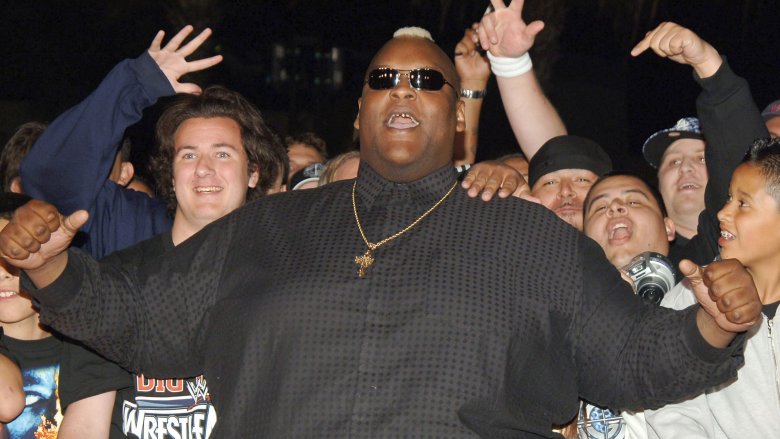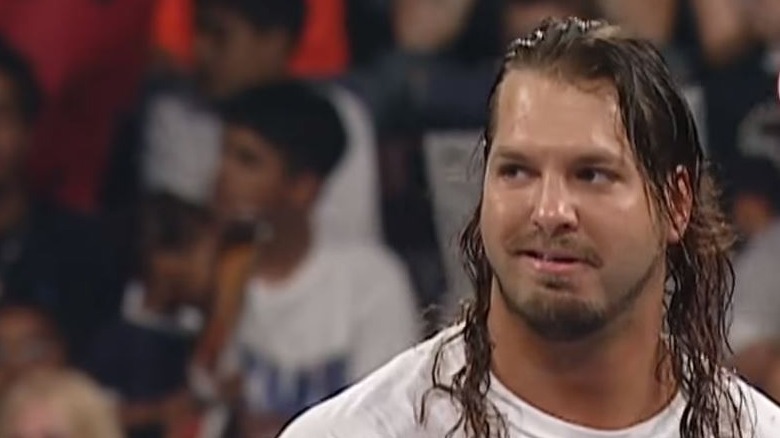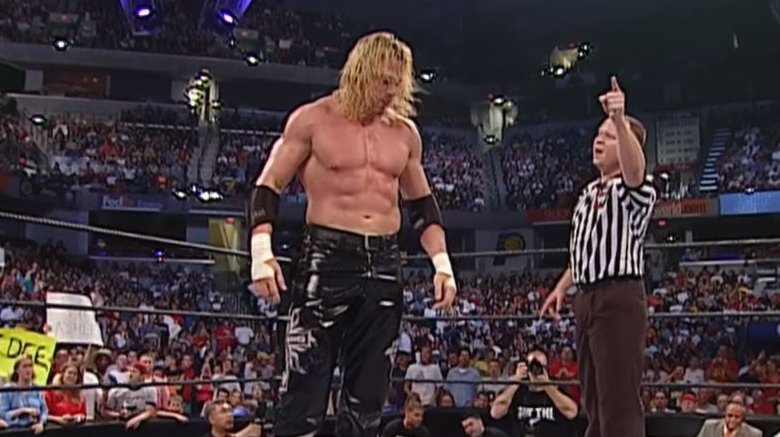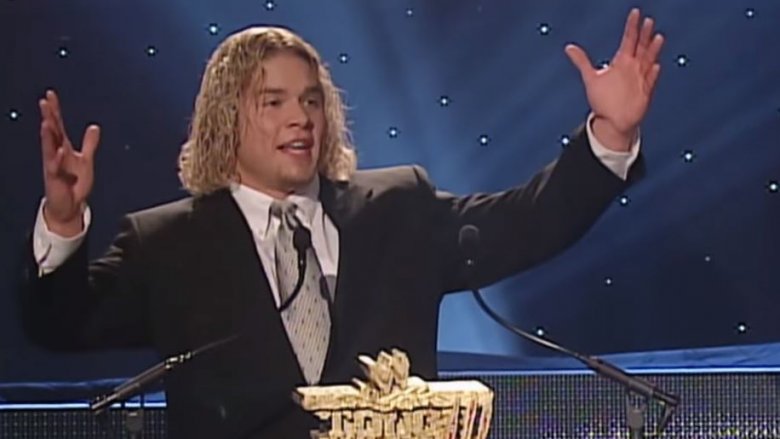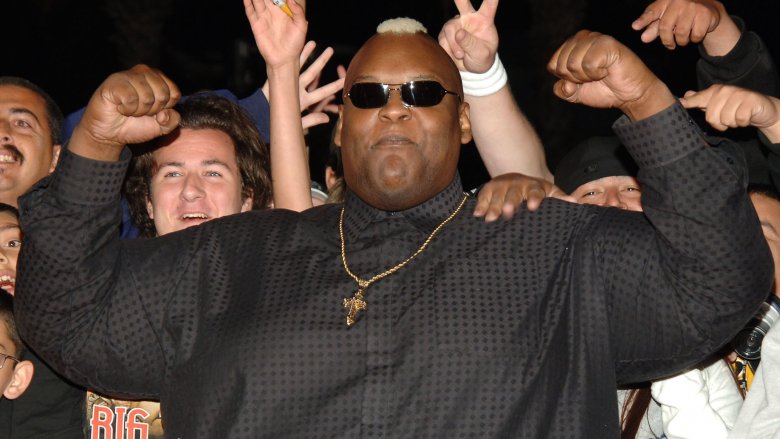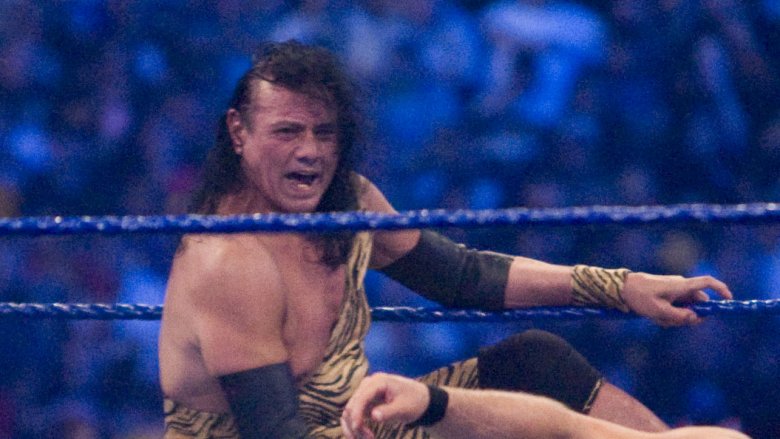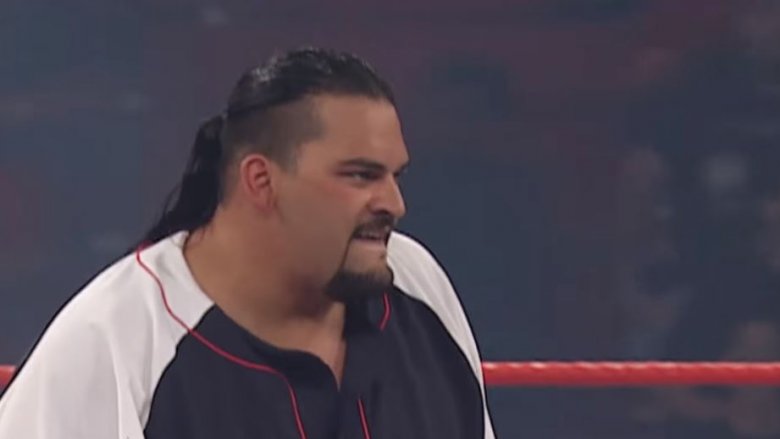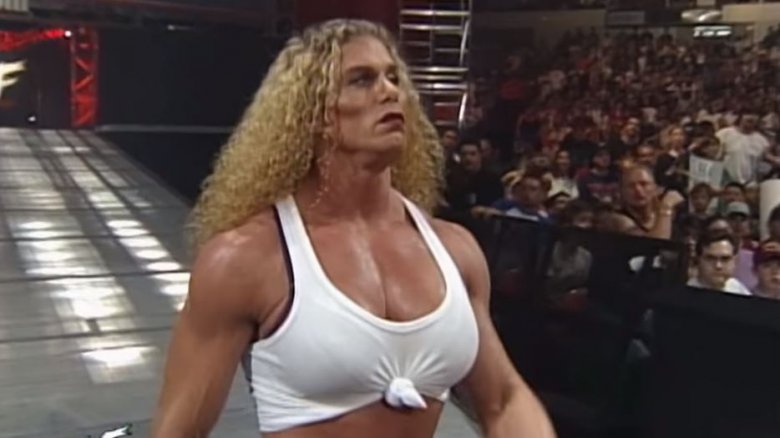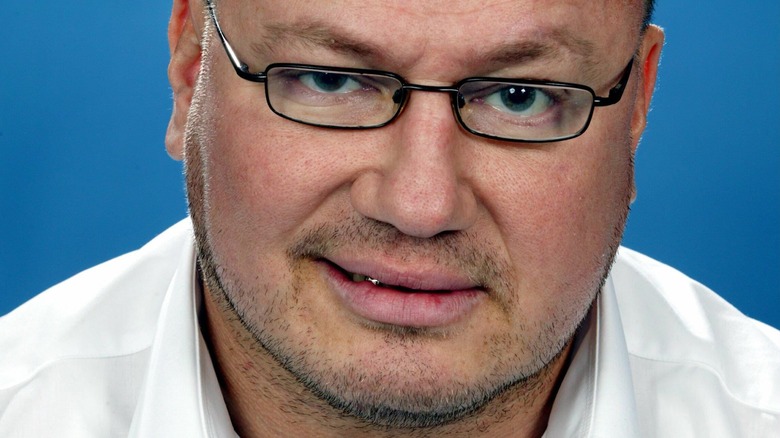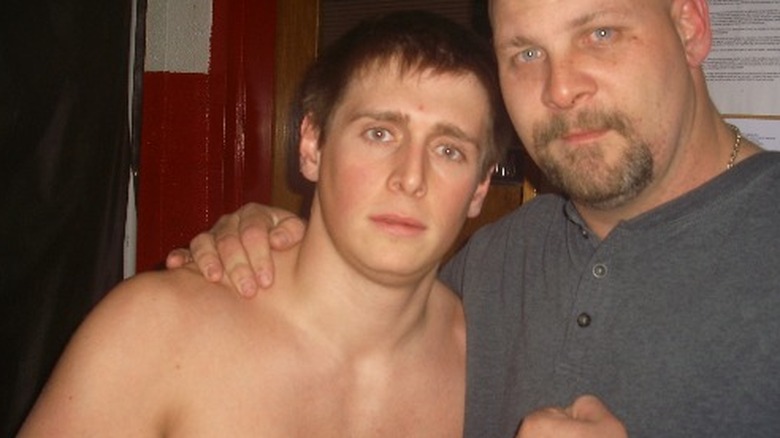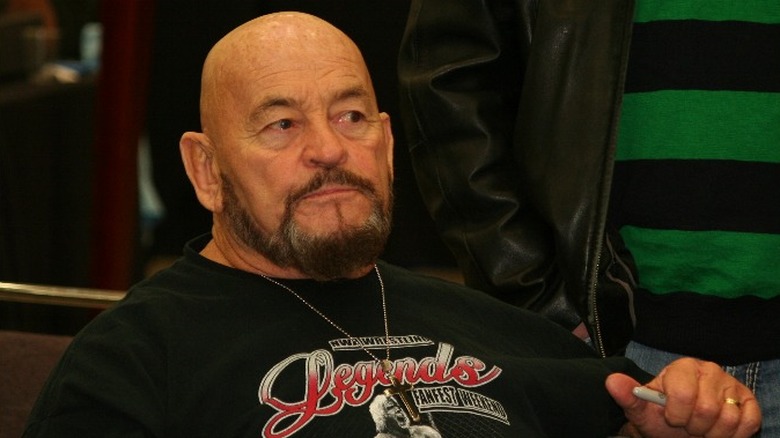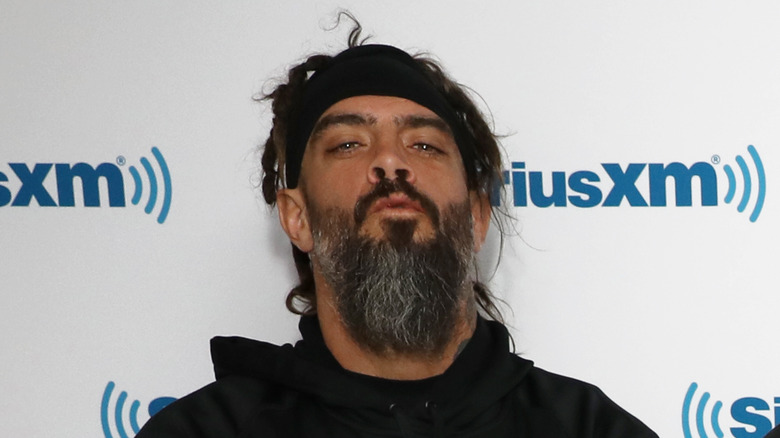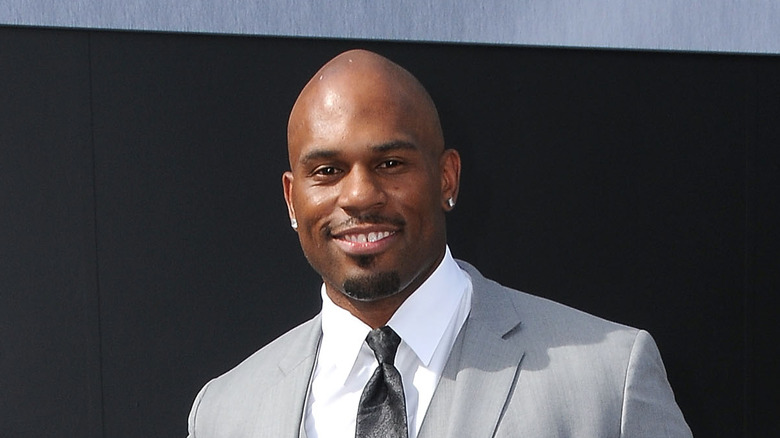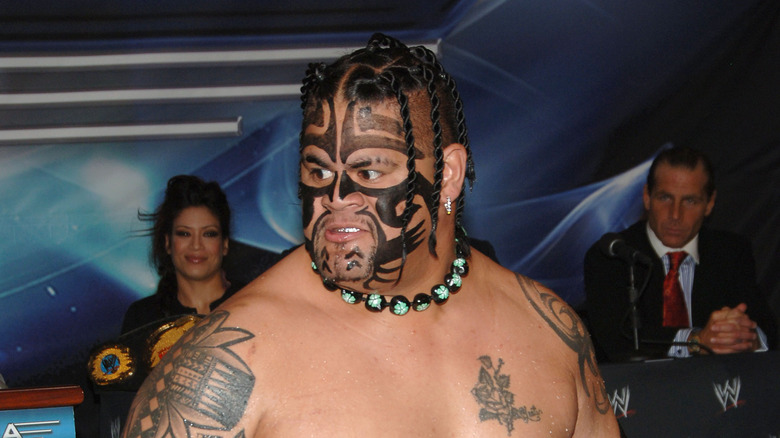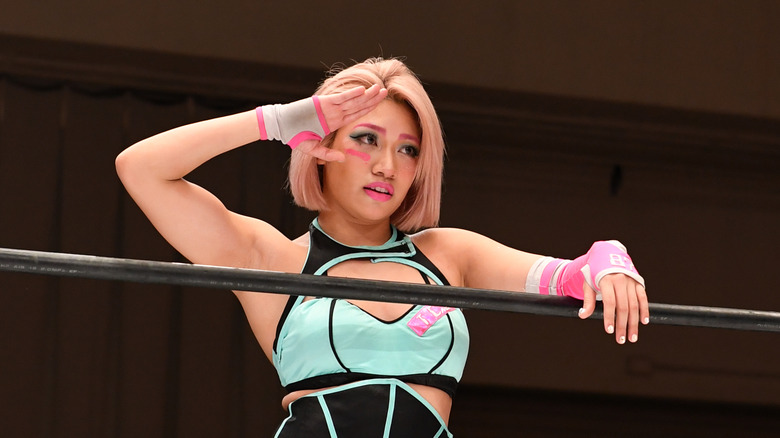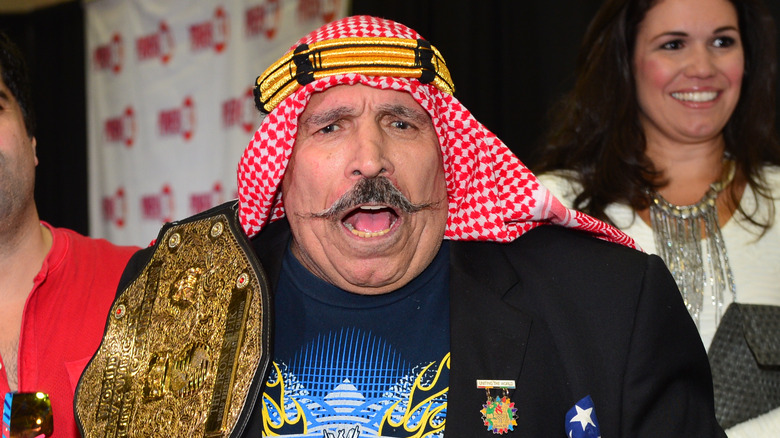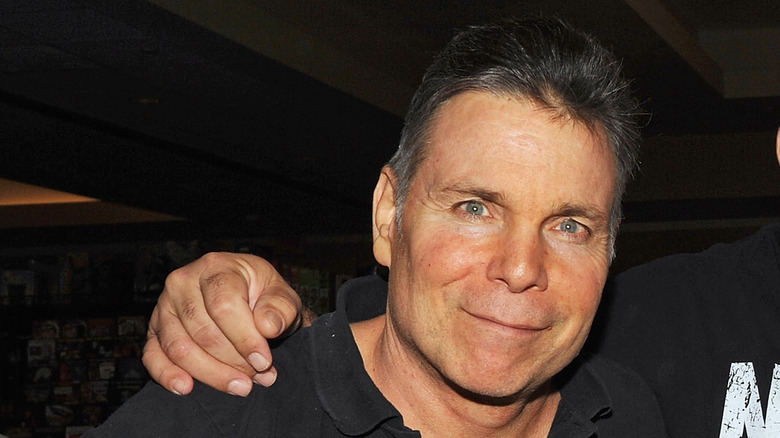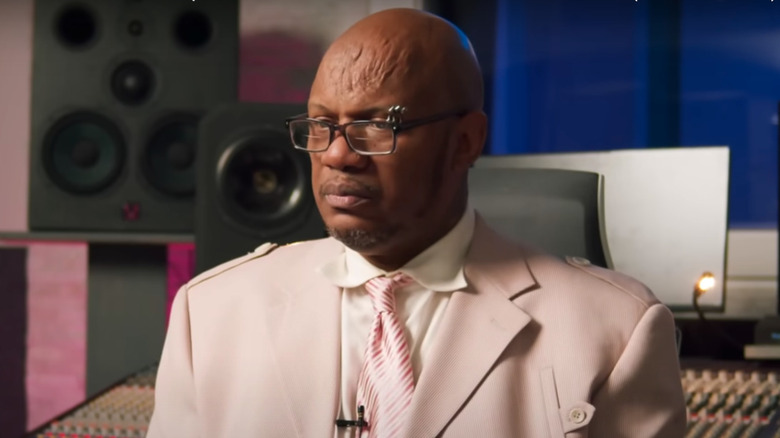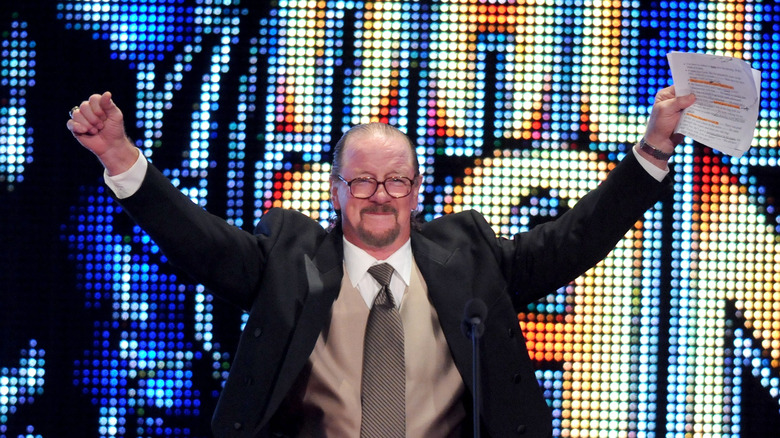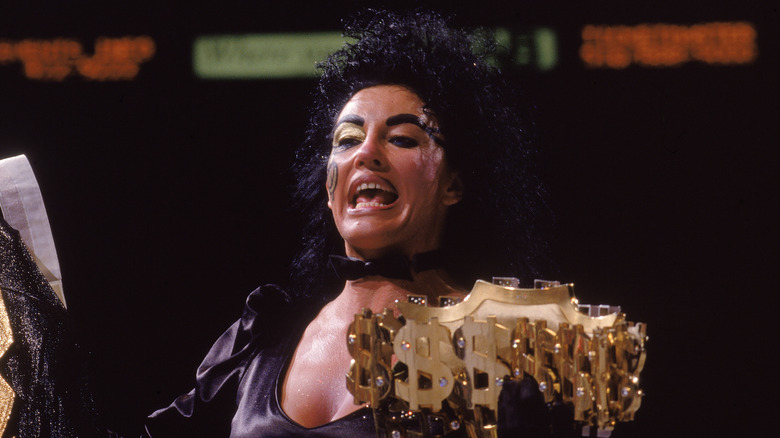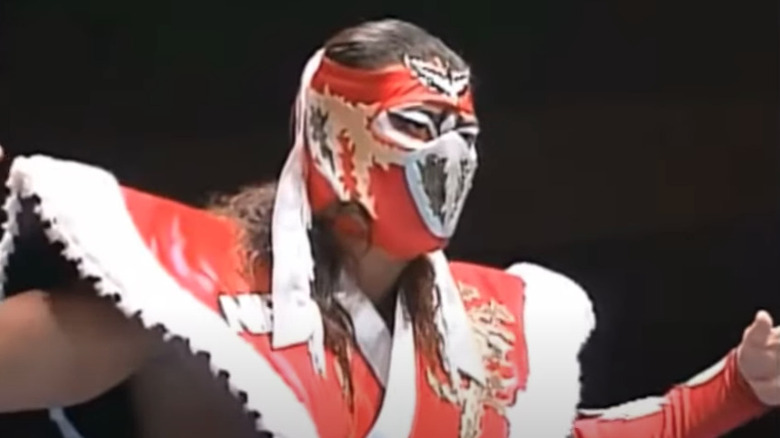Professional Wrestlers You May Not Know Passed Away
Professional wrestling is a job that takes a massive toll on your body and mind. A main event performer can do hundreds of shows a year. Even if you ignore all the bumps and injuries from actual matches, the constant training, traveling, and media responsibilities leave them precious little time to recover. There's also the stress of getting everything right so they don't injure themselves or their opponents, the fact that pro wrestling has no off-season whatsoever, and the many unhealthy activities such as the misuse of painkillers and alcohol. It's a grueling way of life, and often a short one.
The media tends to report some of the more famous wrestlers who have passed away, but the barrage of dead wrestlers is unfortunately so constant that it's easy to miss plenty of names you might recognize. Let's fix this and pay homage to some of the men and women who sacrificed their own health to briefly entertain us. After all, the least we can do after that ultimate sacrifice is to find out how they left this world.
The following article mentions addiction, death by suicide, and allegations of sexual assault.
Chris 'Kanyon' Klucsarits
The wrestling career of Chris "Kanyon" Klucsarits was always marred with difficulties. His posthumous autobiography describes his life as a closeted gay man in an ultra-macho profession. Kanyon was not ashamed of being homosexual, but he strongly suspected that coming out would not mesh well with his career, so he took extreme measures to protect his secret. He had sex with female groupies to keep up appearances, and once had to escape a gay bar when his coworkers wandered in for drinks after the other watering holes had closed.
When Kanyon finally came out in 2001, his worst fears seemed to come true. After an unfortunate series of injuries, he found out that his comeback was a humiliating, Boy George-themed joke segment that ended with extremely stiff chair shots from The Undertaker. Eventually, the only airtime he received was on "Velocity," the least-appreciated WWE show at the time. In 2003, Kanyon's life took an even more tragic turn. He nearly died by suicide, ended up in the hospital, and was diagnosed with bipolar disorder. He realized that he was wrestling with his opponents, sexuality, and mental illness.
Though Kanyon ended up leaving the WWE, it looks like he never found true peace. Kanyon was found dead in April 2010, with a large number of pills near his body. He was 40 years old.
Andrew 'Test' Martin
During his tenure in the WWF/WWE, Andrew "Test" Martin held the European, Intercontinental, and Tag Team championships. He might have climbed even further up the ladder if he hadn't suffered a neck injury in 2004. As things were, he was released from the company after undergoing spinal fusion surgery.
Test was aware of the short life span of professional wrestlers and was determined to escape the curse of drugs in particular. He once said (via The Sydney Morning Herald): "I just turned 32 years old and went to eight funerals this year. Do I want to join that club?" He did not want to join that club, but unfortunately, he did. In 2009, a little over a year after the interview, the 33-year-old former wrestler was found dead in his Florida condo. He had died of an accidental overdose of painkillers.
Test's fate is particularly tragic because his story was always unlikely to end well, even if he'd managed to escape an overdose. A doctor who examined his body found alarming signs of brain damage. In fact, Test's brain resembled that of an Alzheimer's patient twice his age. Another wrestler with that kind of severe brain damage was Chris Benoit — a fellow Canadian WWE star who killed his family and died by suicide in 2007, for seemingly no reason.
Matt Cappotelli
In 2003, Matt Cappotelli was doing very well for himself. Together with John Hennigan, he had just won the WWE Tough Enough III competition, and franchise stardom seemed imminent. But why did his co-winner reach main event status with his John Morrison gimmick, while Cappotelli himself never made much of an impact?
It's not because Cappotelli didn't have what it takes – he just fought his battles on a far more serious stage than the wrestling ring. In 2005, Cappotelli was diagnosed with a brain tumor, which ended his career before he could reach the highest levels. The first tumor was successfully removed, but that was only a temporary respite. Despite yearly screenings, Cappotelli started having headaches and seizures in 2017, and a surgery failed to remove the malignant tumor. After consulting his neuro-oncologist, Cappotelli decided to cease medical interventions. He died in 2018, exactly one year after the surgery. He was only 38 years old.
Nelson Frazier Jr.
If the lifestyle of a professional wrestler can be difficult for the average superstar, imagine what it must have been like for Nelson Frazier Jr. The 6'9", 487-pound giant was one of the largest competitors to ever climb in the ring. Even though he was never going to perform many high-flying moves, he was still a threatening presence, and lighter on his feet than you'd expect from a man who was almost as wide as he was tall.
Frazier intimidated his fellow performers under various gimmicks: the successful Mabel, the vicious entity known as Viscera, and finally, a light-hearted "world's largest love machine" persona that morphed into a brand new character called Big Daddy V. Unfortunately, the same girth that made Frazier such a fearsome ring presence eventually took its toll, as the physicality and grueling schedules of the profession finally caught up with him. In 2014, WWE released a statement that Frazier had passed away at the young age of 43. Although the company was tactfully quiet about the actual cause of death, one of his former comrades, Eric Simms, said (via Bleacher Report) that Big Vis died of a massive heart attack.
Jimmy Snuka
Jimmy Snuka, whose real name was James Reiher, was one of the first men to show America that wrestling could be more than a ground-based game. His Superfly Splash from the top rope helped him reach superstar status in the 1980s, and that the famous dive from the top of a steel cage in his match against Don Muraco cemented his position as a pro wrestling legend.
Still, Snuka's legacy has another, darker side. His mistress died in mysterious circumstances in 1983, and a cloud of suspicion has hung above the WWE Hall of Famer ever since. Snuka has always maintained that the woman died from a fall in their hotel room, but the prosecutors suspected she had been beaten. The case would almost literally follow the wrestler to the grave. Although the death was initially ruled accidental, the victim's relatives successfully sued Snuka for wrongful death. In 2013, an investigation by the Morning Call newspaper raised some new questions about the case, and in 2015, Snuka was charged with third-degree murder and involuntary manslaughter. However, he was already 73 years old and at the brink of death himself. The court dismissed the murder case because of Snuka's advanced dementia and rapidly failing health. He died just one week later.
Matt 'Rosey' Anoa'i
People who don't know Matthew "Rosey" Anoa'i's history might think that he was just a random large man with a penchant for throwing people around the wrestling ring. However, the tag-team expert was actually a member of the famous Anoa'i wrestling family. He was the older brother of Roman Reigns and the cousin of The Rock. Despite his family's notorious charisma, Rosey was never quite able to make it as a singles star. However, he carved a niche for himself in the tag team division. He first partnered with his cousin Jamal, who went on to become the popular wildman character Umaga and also died before his time. Later, he formed a successful team with The Hurricane. Together, they captured the World Tag Team Championship in 2005.
Unfortunately, Rosey was a very, very massive man working a physically demanding job, which did not help his odds of reaching old age. In 2017, at 47 years old, Rosey's death was made public by the family. His actual cause of death has not been publicly released, but he had been diagnosed with congestive heart failure and atrial fibrillation in 2014. He continued to wrestle until his death.
Nicole Bass
Nicole Bass was not your typical wrestling diva. She was a tall, highly muscular lady who towered over the competition, and mostly played a bodyguard-type character instead of an active wrestler. Her start in the business was equally unorthodox. She was a successful bodybuilder whose large frame and deep voice led to a gig on Howard Stern's radio show, which she in turn negotiated to a budding wrestling career ... and another career as an adult film actress. Bass didn't have the longest tenure in wrestling, as she was released just a few months after she was signed. She then sued WWF for no less than $120 million, claiming she had been wrongly terminated, that another performer had sexually assaulted her, and that the company was a discriminatory workplace that paid women less than men. A jury ruled against her.
How the 52-year-old Bass died in 2017 is slightly uncertain. The cause of death was reported as a stroke, but most of the first-hand information comes from Bass' partner, Kristen Marrone. According to Marrone, Bass just suddenly got very sick and they took her to a hospital, but nothing could be done.
Ludvig Borga
Ludvig Borga was one of the many generic monster heels of the 1990s. The man behind the character, on the other hand, was far from bland. Tony Halme never became what you'd call a WWF legend, but that was just one stop in his strange career. Apart from wrestling, he worked as a bodyguard before moving back to his native Finland and becoming a boxer. Halme's boxing career was a massive hit. He won the national heavyweight championship and sold out arenas. He also tried to expand to MMA, but opponents such as Randy Couture soon showed him what was up.
Perhaps the strangest and most notorious move in Halme's career came in 2003, when he ran for the Finnish parliament as a member of the True Finn party. He was elected and immediately started championing strange and impossible policies, such as saving Finnish funds by sending drug dealers to Russian prisons. His private life also became increasingly erratic. In 2004, the esteemed Member of Parliament was arrested and given a suspended sentence for firearms and drug violations. At this point, it was clear that Halme wasn't doing well. After several alcohol-related arrests and a stint at a mental institution, the 47-year-old former heel died by suicide in 2010.
Reid Flair
Like his father Ric Flair – one of the greatest wrestlers in history – Reid Flair (pictured above center with Mayhem) was a wrestler. However, he wasn't in the wrestling business for glory or championships, or even cash. He was in the game mostly to get the respect of his father. This quest was cut tragically short: Ric Flair found Reid in a hotel room in Charlotte, North Carolina, dead of an apparent overdose of heroin and prescription medication in 2013. The younger Flair was only 25 years old.
In 2015, what must have been the worst day of Ric Flair's life returned to haunt him in a very unexpected way. His daughter Charlotte was the WWE Divas Champion at the time, and he frequently fought on her side. One particular TV angle took a dark turn as wrestler Paige, Charlotte's opponent in an upcoming match, started talking about Reid's death in an attempt to provoke Charlotte. This incident left Ric Flair in a strange place: He was deeply hurt by the decision to use his dead son to hype up a match, but was afraid to say anything in case he'd accidentally sabotage Charlotte's career. Way to go, WWE.
Ivan Koloff
Every article about professional wrestlers features more than enough tragedy, so it's nice to find out that people like Ivan Koloff exist. Sometimes, it's just good to know that one of the most ruthless wrestling heels in history was actually a decent guy, who retired with no fuss after a 30-year career, and lived a long, fulfilling life.
Today, Koloff may seem like a generic "evil foreigner" villain, but in his heyday in the 1970s and 1980s, he was a truly formidable presence. The "Russian Bear" was actually Canadian, but this didn't stop him from wearing a hammer-and-sickle singlet and becoming a man everyone loved to hate. He won the company's WWWF World Heavyweight Championship by ruthlessly crushing Bruno Sammartino's throat at Madison Square Garden. This ended Sammartino's legendary seven-year championship reign. He was known as a notorious, fan-favorite villain, and wrestling legends such as Ric Flair, Hulk Hogan, and the Iron Sheik paid their respects to Koloff after he passed away.
The man behind the character was, of course, very different than the brutal heel who finished his opponents with bear hugs. The scary-looking Koloff was actually a sweet, gentle person who became an ordained minister after his retirement in the 1990s. In this capacity, he toured the world for over two decades, before finally succumbing to liver cancer at the respectable age of 74.
Jay Briscoe
Jamin Pugh, who wrestled as Jay Briscoe, was known for performing with his brother, Mark as the Briscoe Brothers. They connected with the audiences with wrestling personas that incorporated their real-life sibling relationship and chicken-farm backstory. "It took years, but we had to convince ourselves to be ourselves," Jay told Sports Illustrated. "Whenever we walked into a locker room, guys knew we grew up on a chicken farm. The guys used to get a kick out of the stories about the chickens and living on the farm, so we thought we'd let everybody see it."
On January 17, 2023, Briscoe had a bad traffic accident when an incoming pickup truck unexpectedly changed lanes and crashed head-first into his car. Briscoe's two daughters survived the crash but the wrestler and the driver of the pickup both died.
Briscoe played a redneck persona and his comments occasionally courted controversy, but behind the scenes, he was also praised for setting an example and supporting LGBTQ+ wrestlers. To illustrate the esteem he was held in, he never worked for the WWE, but the company's Chief Content Officer Paul "Triple H" Levesque was still quick to pay his tributes on X, formerly known as Twitter. "An incredible performer who created a deep connection with wrestling fans across the globe. My condolences to the family and friends of Jay Briscoe," Triple H tweeted.
Shad Gaspard
Professional wrestling has its heroes and villains, but the people behind the larger-than-life roles are generally just that — people. However, WWE wrestler-turned-actor Shad Gaspard proved in his final moments that he was very much a hero in real life.
On May 17, 2020, Gaspard was swimming with his son on Venice Beach, California, when a riptide swept them away from the shore. Gaspard put his son first when a lifeguard arrived. "[The lifeguard] was going to try to rescue both," L.A. County Lifeguard Chief Ken Haskett told NBC News. "But the father, in his last few words, said, 'Save my son.'" Immediately after giving the child to the lifeguard, Gaspard went with the waves. His son made it, but the wrestler himself didn't. He was found dead on May 20, 2020.
Many wrestlers and wrestling personalities reacted to the news of Gaspard's death with shock and sadness, and praised his determination to protect his son in his final moments. Dwayne Johnson shared one of the most heartfelt tributes to his fallen colleague on Instagram. "This one hurts," Johnson wrote. Great guy. My deepest condolences and love to Shad Gaspard's wife, son and family. Shad drowned in the ocean, but not before instructing lifeguards to save his 10yr old son first. That's the love of a father. This is a tough one to process. Love and light to Shad's family. And your warrior spirit lives on through your son."
Edward Fatu
By any metric, Edward Fatu was a great pro wrestling superstar. Along with his real-life cousin and tag team partner Matt "Rosey" Anoa'i, he was part of the esteemed Anoa'i family that has produced numerous top stars of the industry, from Dwayne "The Rock" Johnson and Rikishi to Roman Reigns and the Uso twins. As his most famous character, "The Samoan Bulldozer" Umaga, he won the WWE Intercontinental Championship and squared off with the company's top stars.
However, Fatu's time in the squared circle ended on a sour note. His repeated violations of the WWE Wellness Program — a company policy that includes but isn't limited to drug tests — prematurely ended his contract in June 2009. In December 2009, he died at just 36 years old.
The cause of the wrestler's death was originally thought to be a heart attack, but this turned out to be just a part of the truth. The tragic details in Fatu's autopsy report revealed that he had died accidentally after ingesting muscle relaxants, painkillers, and the anti-anxiety drug Diazepam. What's more, Fatu had a hypertensive cardiovascular disease, which contributed to the death — as well as problems with his liver.
Hana Kimura
Japanese professional wrestler Hana Kimura was a second-generation talent who seemed to have a stellar career ahead of her when she died by suicide in May 2020. Strangely, the circumstances that led to her death weren't related to wrestling, but reality television.
When Kimura joined the cast of the Japanese reality show "Terrace House," the show portrayed her in a negative, aggressive light, which resulted in severe cyberbullying. Kimura and her mother have both made known that the show deliberately portrayed her as an aggressive villain archetype, which in turn drew the show's notoriously vocal fandom's online ire at her.
The connection between the fans' barrage of abusive comments and Kimura's death led to Kimura's mother suing the production company and setting up a non-profit organization in Kimura's memory. As of May 2021, three of Kimura's bullies have been identified and sentenced to pay damages or fines — and after looking into its cyberbullying legislation, Japan made online abuse an imprisonable offense in 2022.
Hossein Khosrow Ali Vaziri - The Iron Sheik
Hossein Khosrow Ali Vaziri, the Iron Sheik, had a highly successful wrestling career and an equally turbulent personal life. However, this may not be what many people know him for. In his later years, the Sheik re-found fame on social media. After his propensity for wild and colorful tirades caught the eye of two Iranian-Canadian brothers, they teamed up with the ex-wrestler to set up an X, formerly known as Twitter, account in his name. The Sheik neither wrote nor posted the profane tweets himself, but they proved popular nevertheless.
Because the X account has reposted both old tweets and other Sheik-themed and wrestling-adjacent material after his death, a casual fan might have missed the fact that the Iron Sheik is no longer with us. Vaziri was 81 years old when he died on June 7, 2023.
The Iron Sheik was such a colorful villain figure that it's easy to forget he was a legitimate amateur wrestler in Iran before moving to the United States. In his youth, the Sheik almost made it to the Olympics, and at one point actually worked as a bodyguard for the Shah. In the U.S., he became a fixture of the 1980s pro wrestling scene. He collided in the ring with folks like Hulk Hogan, winning and losing championships, and generally kept busy in a way that landed him a spot in the WWE Hall of Fame.
Lanny Poffo
Known as "The Genius" and "Leaping Lanny," high-flying wrestler and memorable wrestling manager Lanny Poffo died on February 2, 2023. He was 68. Poffo was a great wrestling talent whose immediate family sometimes overshadowed him — since his brother just so happened to be the iconic "Macho Man" Randy Savage. Even the brothers' parents made their mark on the business, since their dad was well-known wrestler Angelo Poffo, and their mother played a role in creating Savage's "Macho Man" nickname.
That's not to say Lanny wasn't a successful member of the Poffo family's pro wrestling dynasty, though. As a wrestler, he was a relatively small performer who used acrobatic and gravity-defying moves, and managed to connect with the audience using frisbees and poetry, of all things. Poffo continued his streak with his "The Genius" gimmick, which cast him in the heel role of the world's most intelligent man.
The Poffo family was tight when it came to wrestling, but where Macho Man attempted to lift his family up with him, Lanny was more interested in putting over other family members — at his own expense if necessary. After his brother's death, Poffo overruled Savage's standing orders that he wasn't to be inducted into the WWE Hall of Fame unless the other two wrestlers in the family get the same treatment — thus allowing Savage to take his place in the sun while willingly stepping away from glory himself.
Jerome 'New Jack' Young
Jerome "New Jack" Young died of a heart attack on May 14, 2021, aged 58. He wrestled a risky and brutal style that could make it seem that someone in the ring was going to get seriously hurt. Sometimes, people did. New Jack's arguably most infamous hour — ECW promotion's Mass Transit Incident — put him in a tag-team match against D-Von Dudley and a new wrestler called Mass Transit, who in reality was a 17-year-old kid called Erich Kulas with zero wrestling experience. After Kulas requested New Jack to help him bleed, Jack cut the boy so deeply that he started bleeding out, leading to a lawsuit and copious media attention.
New Jack had a difficult childhood, and spent two years in prison for robbery before focusing on football and, not long afterward, turning to pro wrestling — as well as other trades, such as bounty hunting. Considering his highly violent wrestling style and extracurricular activities, it's easy to guess that New Jack was quite a polarizing figure ... but nevertheless so respected that when he died, even the WWE — where he never wrestled — paid its respects.
Terry Funk
Is it any wonder that people might automatically assume that Terry Funk is still fighting opponents in some independent promotion? Even if you knew that he died in a hospital on August 23, 2023, it's the kind of information that's easy to dislodge from your memory. After all, he just had a match in 2017.
The thing about Funk is that he was at it for a long, long time. He started wrestling in 1965, and was 79 when he died — which means he was in his 60s when he wrestled his last WWE match in 2006, and near his mid-70s in that final 2017 match.
During his decades in the business, Funk worked in many different promotions, from Japan to the WWE — where he's a Hall of Famer, of course. A second-generation wrestler who could use multiple wrestling styles as required, Funk was known to tag team with his brother, Dory Funk, Jr. Still, he was arguably most famous for his penchant for using various melee weapons during his matches, as well as his relentless, extreme style that makes it a small miracle that he could work as long as he did.
Sherri Martel
WWE Hall of Famer "Sensational" Sherri Martel worked in multiple wrestling promotions as both a wrestler and a manager. In the latter capacity, she had storylines with many of the biggest male stars of the industry, from Shawn Michaels to "Million Dollar Man" Ted DiBiase. On June 15, 2007, the 49-year-old Martel retired to her bed after feeling unwell, and was found dead shortly afterward. An autopsy revealed several drugs in her system, but the death was deemed accidental.
The reason people might not have heard of Martel's death is that it happened shortly before one of the most terrifying events in pro wrestling history — the horrific crimes of Chris Benoit, who killed his family and died by suicide between June 22nd and June 24th, 2007. Strangely, timing wasn't the only connection between these two tragedies. A friend of Martel, Kevin Sullivan, was once married to Benoit's wife and victim, Nancy Benoit.
Eiji 'Hayabusa' Esaki
Eiji "Hayabusa" Esaki was a masked wrestler who was highly influential in various Japanese promotions, and also wrestled for ECW in the U.S. The 47-year-old star died of a subarachnoid hemorrhage — that is, bleeding around the brain — on March 3, 2016.
Hayabusa was a pioneer of the high-flying style, and several notable wrestlers paid tribute to him after news of his death arrived. "Very sad to hear the passing of Hayabusa. Easily one of the most inspirational junior heavyweight wrestler of all time. RIP Eiji Ezaki," AEW's Kenny Omega wrote on X, formerly known as Twitter. To put this comment in context, Omega himself is considered to be one of the best wrestlers in the business.
Unfortunately, Hayabusa's in-ring career was quite short, and he hadn't wrestled in 14 years before his death. Wrestling moves can be incredibly dangerous, and in 2001, the star broke his neck during a match after a springboard moonsault went awry. The incident paralyzed him, but he had recovered some use of his legs before he died.
If you or anyone you know needs help with addiction issues, may be the victim of sexual assault, or is struggling or in a crisis, contact the relevant resources below:
-
The Substance Abuse and Mental Health Services Administration website or contact SAMHSA's National Helpline at 1-800-662-HELP (4357).
-
The Rape, Abuse & Incest National Network website or contact RAINN's National Helpline at 1-800-656-HOPE (4673).
-
Call or text 988 or chat 988lifeline.org
